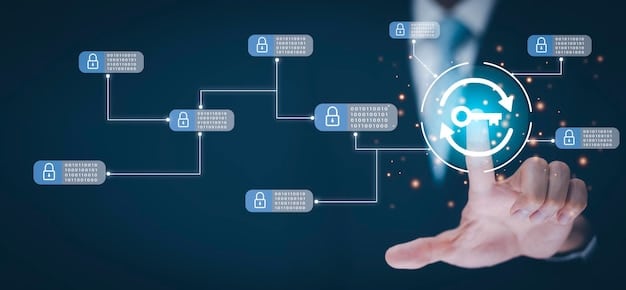Differential Privacy in AI Research: A US Guide to Protect Data

Implementing differential privacy in AI research is crucial for protecting sensitive data, especially in the US, ensuring compliance with privacy regulations while still enabling valuable insights from the data.
In the United States, the importance of protecting sensitive data in Artificial Intelligence (AI) research cannot be overstated. This article serves as a comprehensive guide on how to implement differential privacy in your AI research to protect sensitive data: a US guide, ensuring both innovation and ethical data handling.
Understanding Differential Privacy for AI in the US
Differential privacy (DP) is a system for publicly sharing information about a dataset by describing the patterns of groups within the dataset while withholding information about individuals in the dataset. It’s particularly relevant in the US due to the increasing focus on data privacy regulations and ethical considerations in AI research.
What is Differential Privacy?
At its core, differential privacy is a mathematical definition of privacy. It ensures that the addition or removal of any single data point in a dataset does not significantly alter the outcome of any analysis performed on that dataset.
Why is it Important in the US?
In the United States, various laws and frameworks such as HIPAA (Health Insurance Portability and Accountability Act) and the California Consumer Privacy Act (CCPA) mandate stringent data protection measures. Differential privacy provides a robust mechanism to comply with these regulations, ensuring that AI research can proceed without compromising individual privacy rights.

- Data Minimization: Collect only the necessary data points for your research.
- Noise Addition: Introduce calibrated noise to the data to obscure individual contributions.
- Privacy Budget: Carefully manage the privacy budget (epsilon and delta) to balance privacy and utility.
Differential privacy isn’t just a technical exercise; it’s a commitment to ethical AI development. By understanding and implementing DP, researchers in the US can lead the way in responsible data science – fostering innovation while respecting individual rights and complying with legal standards.
Key Concepts of Differential Privacy
To effectively implement differential privacy, it’s crucial to understand its core components. These concepts provide the foundation for protecting sensitive data while preserving data utility for meaningful analysis.
Epsilon (ε) and Delta (δ)
Epsilon (ε) represents the privacy loss, indicating how much the privacy of individuals is compromised. A smaller epsilon value means stronger privacy protection. Delta (δ) is the probability that the differential privacy guarantee might fail. It represents the risk of a complete privacy breach. Typically, delta is set to be very small.
Sensitivity
Sensitivity measures the maximum change in the outcome of a query when a single individual’s data is added or removed from the dataset. It’s important to accurately calculate the sensitivity of your queries to calibrate the amount of noise needed to ensure differential privacy.
Noise Addition Mechanisms
Noise addition is a key technique in differential privacy. Mechanisms like the Laplace mechanism and Gaussian mechanism add random noise to the query results to obscure individual contributions.
- Laplace Mechanism: Adds noise drawn from a Laplace distribution, suitable for queries with bounded sensitivity.
- Gaussian Mechanism: Adds noise drawn from a Gaussian distribution, often used for more complex queries and compositions.
- Exponential Mechanism: Used when the output is not numerical but rather from a discrete set, choosing outputs randomly based on a scoring function.
By grasping these key concepts, AI researchers in the US can make informed decisions about how to best apply differential privacy techniques to their specific research contexts. This understanding ensures that privacy protections are robust and effective.
Steps to Implement Differential Privacy in AI Research
Implementing differential privacy requires a structured approach. By following these steps, AI researchers in the US can effectively integrate DP into their projects, ensuring robust privacy protection for sensitive data.

Step 1: Data Preprocessing and Sanitization
Before applying any DP techniques, it’s essential to preprocess and sanitize the data. This involves removing or masking any direct identifiers and ensuring that the data is in a format suitable for DP applications.
Step 2: Sensitivity Analysis
Determine the sensitivity of the queries or algorithms you plan to use. This involves calculating the maximum possible change that a single individual’s data can cause in the output. Accurate sensitivity analysis is crucial for calibrating the amount of noise needed to preserve privacy.
Step 3: Choose a Noise Addition Mechanism
Select an appropriate noise addition mechanism based on the type of query and the desired level of privacy. The Laplace mechanism is suitable for queries with bounded sensitivity, while the Gaussian mechanism might be more appropriate for complex compositions.
- Calibrate Noise: Adjust the amount of noise based on the sensitivity and the privacy budget.
- Apply the Mechanism: Add the noise to the query results to ensure differential privacy.
- Verify Privacy: Confirm that the chosen parameters meet the specified privacy guarantees.
By following these structured steps, AI researchers in the US can successfully implement differential privacy in their projects, ensuring that sensitive data is protected while valuable insights are still gleaned from the data.
Tools and Libraries for Differential Privacy
Several tools and libraries are available to facilitate the implementation of differential privacy. These resources can help AI researchers in the US integrate DP techniques into their projects more efficiently.
Google’s Differential Privacy Library
Google offers an open-source Differential Privacy library designed to make it easier for developers to implement DP in their applications. It provides tools for calculating privacy budgets, adding noise, and performing various DP operations.
Microsoft’s SmartNoise
SmartNoise is another open-source project that provides a comprehensive toolkit for implementing differential privacy. It includes tools for data preprocessing, sensitivity analysis, and noise addition, making it easier to build privacy-preserving applications.
OpenDP
The Open Differential Privacy (OpenDP) initiative aims to create a trusted, open-source software ecosystem for differential privacy. It provides a platform for developing and sharing DP tools and techniques.
- Python DP Libraries: Libraries like PyDP offer implementations of DP mechanisms in Python.
- R DP Packages: Packages like diffpriv provide functions for adding differential privacy to R-based analyses.
- Specialized Tools: Tools tailored for specific tasks like DP-SGD (Differentially Private Stochastic Gradient Descent) are available.
By leveraging these tools and libraries, AI researchers in the US can accelerate the adoption of differential privacy in their projects, ensuring that data privacy is a key consideration in AI development. These resources provide practical support for implementing DP, making it more accessible to researchers across various domains.
Challenges and Considerations in Differential Privacy
While differential privacy offers strong privacy guarantees, it’s not without its challenges. AI researchers in the US need to be aware of these considerations to effectively implement DP in their projects.
Balancing Privacy and Utility
One of the main challenges in differential privacy is balancing the level of privacy protection with the utility of the data. Adding too much noise can protect privacy but also significantly reduce the accuracy and usefulness of the data.
Composition Theorems
Understanding composition theorems is crucial when performing multiple queries on the same dataset. Each query consumes a portion of the privacy budget (epsilon and delta), and the total privacy loss accumulates over multiple queries. Carefully managing the privacy budget is essential to maintain strong privacy guarantees.
Implementation Complexity
Implementing differential privacy can be complex, requiring a deep understanding of both the mathematical foundations and the practical aspects of noise addition. It’s important to have the right expertise and tools to ensure that DP is implemented correctly.
- Accurate Sensitivity: Incorrect sensitivity calculations can lead to insufficient or excessive noise.
- Budget Management: Overspending the privacy budget can compromise privacy guarantees.
- Utility Preservation: Striking the right balance between privacy and data utility is essential.
By recognizing these challenges and considerations, AI researchers in the US can approach the implementation of differential privacy with a realistic perspective. This awareness allows for more effective planning and execution, ensuring that DP is applied in a way that maximizes both privacy protection and data utility.
Future Trends in Differential Privacy for AI
The field of differential privacy is constantly evolving, with new techniques and applications emerging regularly. AI researchers in the US should stay informed about these trends to leverage the latest advancements in DP.
Advancements in Noise Addition Mechanisms
Researchers are continually developing new noise addition mechanisms that offer better privacy-utility trade-offs. These mechanisms aim to provide stronger privacy guarantees while minimizing the impact on data accuracy.
Differential Privacy in Federated Learning
Federated learning, where AI models are trained on decentralized data sources, is becoming increasingly popular. Integrating differential privacy into federated learning frameworks can provide strong privacy guarantees for the data shared by individual participants.
Applications in Healthcare and Finance
Differential privacy is finding increasing applications in sensitive sectors such as healthcare and finance. In healthcare, DP can enable the sharing of medical data for research purposes while protecting patient privacy. In finance, DP can be used to analyze transaction data without revealing individual financial information.
- Automated DP Tools: Developing automated tools to simplify the implementation of DP.
- Scalable DP Solutions: Creating DP solutions that can handle large datasets efficiently.
- Enhanced Privacy Metrics: Refining privacy metrics to better quantify and manage privacy risks.
By staying abreast of these future trends, AI researchers in the US can position themselves at the forefront of privacy-preserving AI development. These advancements promise to make DP more accessible, efficient, and effective, paving the way for more widespread adoption across various industries.
| Key Concept | Brief Description |
|---|---|
| 🛡️ Differential Privacy | Ensures individual data points’ addition/removal doesn’t significantly alter analysis outcomes. |
| 📊 Epsilon (ε) & Delta (δ) | Epsilon represents privacy loss, delta the failure risk of DP guarantees. Lower epsilon means stronger privacy. |
| ⚙️ Noise Addition | Adding calibrated noise is a key technique using Laplace or Gaussian mechanisms to obscure individual data contributions. |
| ⚖️ Privacy Budget | Managing a privacy budget is critical, especially when performing multiple queries to avoid cumulative privacy loss. |
Frequently Asked Questions (FAQ)
▼
The main goal is to protect the privacy of individual data points within a dataset while still allowing useful information to be extracted for analysis. It ensures that the contribution of any single individual is obscured.
▼
Epsilon represents the privacy loss parameter. A smaller epsilon value indicates a stronger privacy guarantee, meaning that the privacy of individuals in the dataset is better protected from being revealed through data analysis.
▼
Differential privacy is used in healthcare to share patient data for research, in finance to analyze transaction data, and in government to release census data. It is also used in AI to train models on sensitive data.
▼
The steps include preprocessing data, analyzing sensitivity, choosing a noise addition mechanism, calibrating noise based on sensitivity and the privacy budget, and then applying the chosen mechanism. Proper management of the privacy budget is also crucial.
▼
Tools include Google’s Differential Privacy library, Microsoft’s SmartNoise, and the Open Differential Privacy (OpenDP) initiative. Various Python and R packages like PyDP and diffpriv are also available to help.
Conclusion
Implementing differential privacy in AI research is not just a technical necessity but an ethical imperative in the US. By understanding the key concepts, following the implementation steps, and leveraging available tools, AI researchers can protect sensitive data while still advancing the field. As data privacy regulations continue to evolve, adopting DP will be crucial for responsible AI development.





